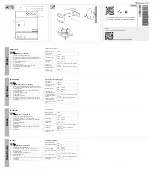
14
Instruction Booklet
IB 33-790-1J
Effective November 2010
Instructions for Low Voltage Power
Circuit Breakers Types DS and DSL
EaToN CorPoraTIoN www.eaton.com
the levering device arms must be rotated away from the
REMOVE position to the TEST position. If charging is
attempted in the REMOVE position, the closing cam will
rotate past the charged position and go through a
trip-free “closing” operation, i.e., the springs will dis-
charge without moving the breaker contacts. Do not
attempt to charge the springs in the DISCONNECT posi-
tion as the same action may occur. After turning the
levering device to TEST position, manually charge the
springs. On manually operated breakers, the springs are
charged by a single stroke downward on the
spring-charge handle, rotating it about 90° toward you
until it suddenly becomes very easy to move and then
tends to run away from your hand. At the same time, you
will hear a metallic “click!” as the over center closing
spring stop is reached. Note that the spring charge indi-
cator now shows “Spring Charged.”
DO NOT RELEASE THE HANDLE BEFORE THE
CHARGING OPERATION IS COMPLETED. TO
RELEASE HANDLE BEFORE CHARGING COMPLE-
TION WILL RETURN HANDLE UPWARDS WITH SUCH
VELOCITY THAT IT MAY BREAK THE HANDLE KNOB
OR CAUSE BODILY INJURY.
HOLD BREAKER TO PREVENT TILTING FORWARD
WHEN HAND CHARGING CLOSING SPRINGS WITH
THE BREAKER ON THE EXTENDED RAILS. OTHER-
WISE, IT MAY TOPPLE TO THE FLOOR AND CAUSE
BODILY INJURY OR EQUIPMENT DAMAGE.
On power operated breakers, a short spring-charge han-
dle is included for emergency operation. This works on a
ratchet principle, and requires 10 to 12 pumping opera-
tions to completely charge the springs. At this point, the
same metallic “click” will be heard; and the spring charge
indicator will show “Spring Charged.” The handle must
not be forced beyond this point.
Note: Power-operated breakers, when being levered
into the compartment, will have the spring-charge
motor run and charge the spring automatically as the
TEST position is reached.
4.3 CLOSE THE BREAKER
The breaker can be closed only when the following condi-
tions are met:
1. The closing springs are charged.
2. The levering arms are in either the TEST position, as
in Figure 7 or in the CONNECT position, Figure 8.
3. The levering device crank handle has been removed
and the shutter is closed.
4. Undervoltage trip device (if included) has been ener-
gized.
5. Blown limiter indicator (for DSL breakers only) is
reset.
Having met these conditions, close the breaker by push-
ing on the close bar. Note that the breaker position indi-
cator shows “Breaker Closed”, against a red background.
Also that the spring-charge indicator now shows “Spring
Discharged.”
Some power-operated breakers are interlocked to pre-
vent manual closing from the close bar on the front panel
when in the CONNECT position. In this case crank the
levering device to the TEST position to operate. This
interlock is covered by Section 5.1.8.2.
It is possible to recharge the springs immediately after
closing the breaker. This results in increased strain on
the mechanism, and it is recommended that this be done
only if the operating procedure requires this condition.
Note: If closing is attempted with the levering arms in
other than the TEST or CONNECT positions, with or
without the levering crank in place, a trip-free “clos-
ing” operation is performed but the breaker contacts
do not close. This trip free type of operation results
in more shock on some parts of the mechanism than
normal closing operations. Therefore, this type of
operation should be avoided if possible.
4.4 OPEN THE BREAKER
The breaker can be opened in the following ways:
1. By hand operation of the trip plate (on the breaker or
on the compartment door.)
2. Automatically by overload, short circuit or undervolt-
age condition.
3. Breakers equipped for power operation can be
tripped electrically by a shunt trip device energized
by hand switch or relay.
For the present purpose of getting acquainted with the
breaker, open it by pushing on the trip plate. Note that the
breaker position indicator now shows “Breaker-open”,
against a green background.
CAUTION
CAUTION
















































